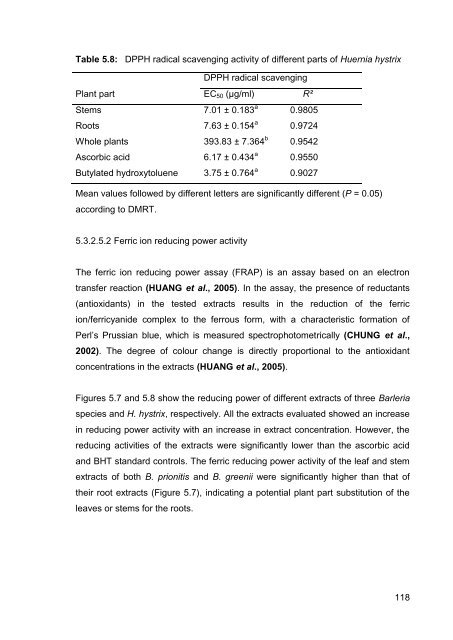Micropropagation and medicinal properties of Barleria greenii
Micropropagation and medicinal properties of Barleria greenii
Micropropagation and medicinal properties of Barleria greenii
Create successful ePaper yourself
Turn your PDF publications into a flip-book with our unique Google optimized e-Paper software.
Table 5.8: DPPH radical scavenging activity <strong>of</strong> different parts <strong>of</strong> Huernia hystrix<br />
Plant part<br />
DPPH radical scavenging<br />
EC50 (µg/ml) R²<br />
Stems 7.01 ± 0.183 a 0.9805<br />
Roots 7.63 ± 0.154 a 0.9724<br />
Whole plants 393.83 ± 7.364 b 0.9542<br />
Ascorbic acid 6.17 ± 0.434 a 0.9550<br />
Butylated hydroxytoluene 3.75 ± 0.764 a 0.9027<br />
Mean values followed by different letters are significantly different (P = 0.05)<br />
according to DMRT.<br />
5.3.2.5.2 Ferric ion reducing power activity<br />
The ferric ion reducing power assay (FRAP) is an assay based on an electron<br />
transfer reaction (HUANG et al., 2005). In the assay, the presence <strong>of</strong> reductants<br />
(antioxidants) in the tested extracts results in the reduction <strong>of</strong> the ferric<br />
ion/ferricyanide complex to the ferrous form, with a characteristic formation <strong>of</strong><br />
Perl‟s Prussian blue, which is measured spectrophotometrically (CHUNG et al.,<br />
2002). The degree <strong>of</strong> colour change is directly proportional to the antioxidant<br />
concentrations in the extracts (HUANG et al., 2005).<br />
Figures 5.7 <strong>and</strong> 5.8 show the reducing power <strong>of</strong> different extracts <strong>of</strong> three <strong>Barleria</strong><br />
species <strong>and</strong> H. hystrix, respectively. All the extracts evaluated showed an increase<br />
in reducing power activity with an increase in extract concentration. However, the<br />
reducing activities <strong>of</strong> the extracts were significantly lower than the ascorbic acid<br />
<strong>and</strong> BHT st<strong>and</strong>ard controls. The ferric reducing power activity <strong>of</strong> the leaf <strong>and</strong> stem<br />
extracts <strong>of</strong> both B. prionitis <strong>and</strong> B. <strong>greenii</strong> were significantly higher than that <strong>of</strong><br />
their root extracts (Figure 5.7), indicating a potential plant part substitution <strong>of</strong> the<br />
leaves or stems for the roots.<br />
118

















